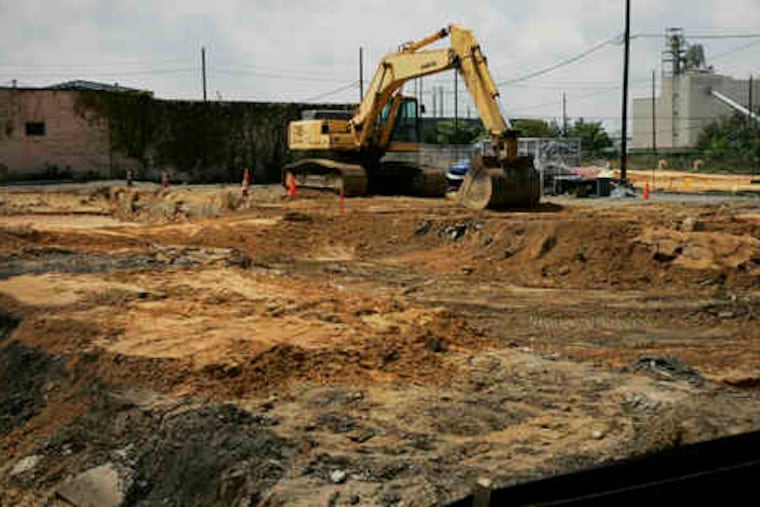EPA to address radioactive water at once-notorious Camden, Gloucester City Superfund site
Radioactive fill was not only left behind at the Superfund sites, but spread around two cities as fill beneath homes, businesses, and even a swim club.

Back before most American homes had electricity, the Welsbach & General Gas Mantle site in Camden and Gloucester City used radioactive thorium to make lamps glow brighter.
That practice stretched from the 1890s to the 1940s, but the remaining toxicity spread around the two cities in fill dirt that homes, businesses, and even a swim club were built upon.
The resulting core Superfund site — which has grown to six separate locations — and the other contaminated properties have long been sore points in neighboring Camden County cities, even as massive amounts of contaminated soil have been removed.
This week, the U.S. Environmental Protection Agency announced a plan to address groundwater contaminated with radium.
“This proposed plan continues EPA’s work to protect residents of Gloucester City and Camden from contamination associated with this site,” the EPA’s acting Region 2 administrator, Walter Mugdan, said in a release. “Having already taken many actions to address the source of contamination, in this case we are focusing on contaminated groundwater.”
But much of the plan means simply letting nature take its course and allowing radioactive decay to occur while the EPA restricts use of the polluted water, monitors it, and continues cleanup of nearby contaminated land. The EPA says that cleaning up the land prevents further contamination of the water.
The agency said it will use “natural processes to break down radioactive elements in the groundwater,” which is not being used as drinking water.
The EPA is referring to the action only as “an interim plan,” meaning it will monitor the groundwater for years to see if it works over the long run. It should take little under six years more for the Radium-228 isotope given off by thorium to decay on its own, according to the agency.
Cleanup of the site stems from the early 1990s when the New Jersey Department of Environmental Protection investigated 1,100 properties in Camden and Gloucester City for radiological contamination. The DEP installed gamma radiation shielding at about 30 properties and radon ventilation systems on three properties. It also purchased one contaminated residential property and relocated a business.
In 1996, a collection of the contaminated sites were placed on the Superfund National Priorities list and the EPA excavated tons of contaminated soil from around Gloucester City and replaced it with clean fill. Up to 100 properties were identified as potentially contaminated, and remediation continued.
The EPA divided its cleanup work into four phases. The last phase is the groundwater cleanup announced this week and is expected to cost $460,000. Removal, the EPA said, is necessary to protect public health and the environment.
According to the U.S. Centers for Disease Control and Prevention, thorium is a naturally occurring substance found in all rocks, soil, aboveground and underground water, plants, and animals. It usually leaves the body if ingested; the main way it can enter the body is by breathing contaminated dust. Studies of thorium workers have shown this can increase the chance of developing lung disease and cancer of the lung or pancreas many years after being exposed.
The EPA has classified the site as “Current Human Exposure Not Controlled,” meaning an unsafe level of contamination had been found and people could be exposed, requiring cleanup of radioactively contaminated soil in residential neighborhoods. To reduce risk of exposure, the EPA and DEP installed shields at some of the properties, and demolished the former General Gas Mantle building in Camden.
The EPA has also completed its cleanup of 120 residential properties in Camden and Gloucester City by removing the contamination but still has to clean 10 to 15 residential and industrial properties.
The contamination began in 1895 when the Welsbach Co. started making gas mantles — a device for generating incandescent bright white light when heated by a flame — at its Gloucester City location, which became the largest of its kind in the United States. The company imported monazite ore as a source of the radioactive element thorium. At its peak, Welsbach produced 250,000 mantles per day.
Leftover material from the processed ore was used as ground fill throughout Gloucester City, including in the construction of homes and businesses, and in low-lying areas around the facility. After it closed in 1940, Welsbach buildings were demolished and that debris was also used as fill.
Its nearby competitor opening in 1912 and closing in 1941, General Gas Mantle in Camden, was smaller but caused similar contamination. The property was combined with Welsbach as part of a single Superfund site.
Some of those areas that have been cleaned for redevelopment now contain businesses, port facilities, ball fields, a school, and even a theater.
The EPA will hold a virtual public meeting on the plan at 6 p.m. on Sept. 8. Registration is at https://welsbach-ggm.eventbrite.com.